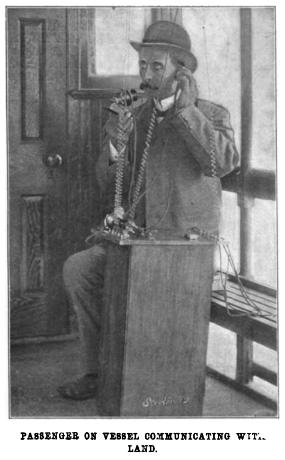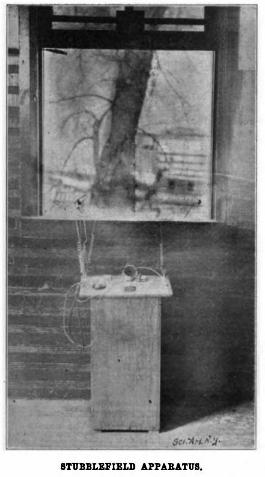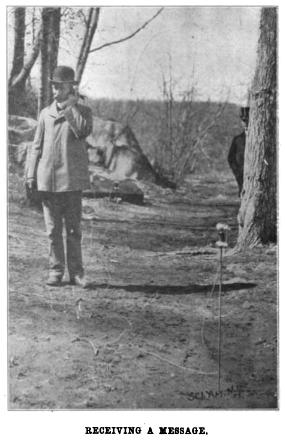
標題: 1928 年差利卓別靈電影出現疑似講手機片段!!! [打印本頁]
作者: LouisLee 時間: 29-10-2010 08:04 標題: 1928 年差利卓別靈電影出現疑似講手機片段!!!
http://www.youtube.com/watch?v=Y6a4T2tJaSU&hd=1
2:42 開始, 又真係幾鬼似!!! 


段片 2010 年 10 月 20 日上載, 已有接近 170 萬人次觀看!!!
作者: LouisLee 時間: 29-10-2010 08:31
喺 wiki 搵到關於無線電話發展歷史資料:
http://en.wikipedia.org/wiki/History_of_mobile_phones
History of mobile phones
The history of mobile phones begins with early efforts to develop mobile telephony concepts using two-way radios and continues through emergence of modern mobile phones and associated services.
Radiophones have a long and varied history going back to Reginald Fessenden's invention and shor
e-to-ship demonstration of radio telephony, through the Second World War with military use of radio telephony links and civil services in the 1950s, while hand-held mobile radio devices have been available since 1973. Mobile phone history is often divided into generations (first, second, third and so on) to mark significant step changes in capabilities as the technology improved over the years.
Pioneers of radio telephony
The early years of the 20th century saw the first attempts at wireless and mobile telephony. In 1908, U.S. Patent 887,357 for a wireless telephone was issued to Nathan B. Stubblefield of Murray, Kentucky. He applied this patent to "cave radio" telephones and not directly to cellular telephony as the term is currently understood.[1] Two years later Lars Magnus Ericsson installed a telephone in his car, although this was not a radio telephone. While travelling across the country, he would stop at a place where telephone lines were accessible and using a pair of long electric wires he could connect to the national telephone network.[2]
In Europe, radio telephony was first used on the first-class passenger trains between Berlin and Hamburg in 1926. At the same time, radio telephony was introduced on passenger airplanes for air traffic security. Later radio telephony was introduced on a large scale in German tanks during the Second World War. After the war German police in the British zone of occupation first used disused tank telephony equipment to run the first radio patrol cars.[citation needed] In all of these cases the service was confined to specialists that were trained to use the equipment. In the early 1950s ships on the Rhine were among the first to use radio telephony with an untrained end customer as a user.
However it was the 1940s onwards that saw the seeds of technological development which would eventually produce the mobile phone that we know today. Motorola developed a backpacked two-way radio, the Walkie-Talkie and a large hand-held two-way radio for the US military. This battery powered "Handie-Talkie" (HT) was about the size of a man's forearm. In 1946 soviet engineers G. Shapiro and I. Zaharchenko successfully tested their version of a radio mobile phone mounted inside a car. The device could connect to local telephone network with a range of up to 20 kilometers.
In December 1947, Douglas H. Ring and W. Rae Young, Bell Labs engineers, proposed hexagonal cells for mobile phones in vehicles.[3] Philip T. Porter, also of Bell Labs, proposed that the cell towers be at the corners of the hexagons rather than the centers and have directional antennas that would transmit/receive in three directions (see picture at right) into three adjacent hexagon cells.[4] At this stage the technology to implement the ideas did not exist nor had the frequencies had been allocated and it would be some years until Richard H. Frenkiel and Joel S. Engel of Bell Labs developed the electronics to achieve this in the 1960s.
During the 1950s the experiments of the pioneers started to appear as usable services across society, both commercially and culturally. In the 1954 movie Sabrina, the businessman Linus Larrabee (played by Humphrey Bogart) makes a call from the phone in the back of his limousine. In 1957 a young Soviet radio engineer Leonid Kupriyanovich from Moscow created a portable mobile phone, and named it the LK-1 after himself.[5] This mobile phone consisted of a relatively small handset equipped with an antenna and rotary dial, and communicated with a base station. The LK-1 weighed 3 kilograms and could operate in a range of up to 20 or 30 kilometers. The battery lasted 20 to 30 hours. The LK-1 was depicted in popular Soviet magazines as Nauka i zhizn. Kupriyanovich patented his mobile phone in the same year. The base station serving the LK-1 (called ATR, or Automated Telephone Radiostation) could connect to local telephone network and serve several customers. During 1958, Kupriyanovich produced a "pocket" version. The weight of improved lighter handset was about 500 grams.
In 1969, a patent for a wireless phone using an acoustic coupler for incoming calls was issued in US Patent Number 3,449,750 to George Sweigert of Euclid, Ohio on June 10, 1969, but did not include dialing a number for outgoing calls.
In all these early examples, a mobile phone had to stay within the cell area serviced by one base station throughout the phone call, i.e. there was no continuity of service as the phones moved through several cell areas. The concepts of frequency reuse and handoff, as well as a number of other concepts that formed the basis of modern cell phone technology, were described in the 1970s. In 1970 Amos E. Joel, Jr., a Bell Labs engineer,[6] invented an automatic "call handoff" system to allow mobile phones to move through several cell areas during a single conversation without interruption.
In December 1971, AT&T submitted a proposal for cellular service to the Federal Communications Commission (FCC). After years of hearings, the FCC approved the proposal in 1982 for Advanced Mobile Phone System (AMPS) and allocated frequencies in the 824–894 MHz band.[7] Analog AMPS was eventually superseded by Digital AMPS in 1990.
A cellular telephone switching plan was described by Fluhr and Nussbaum in 1973,[8] and a cellular telephone data signaling system was described in 1977 by Hachenburg et al.[9] In 1979 a U.S. Patent 4,152,647 was issued to Charles A. Gladden and Martin H. Parelman, of Las Vegas for an emergency cellular system for rapid deployment in areas where there was no cellular service
作者: foureyesfatboy 時間: 29-10-2010 09:12
引用:
原帖由 LouisLee 於 29-10-2010 08:04 發表  http://www.youtube.com/watch?v=Y6a4T2tJaSU&hd=1 2:42 開始, 又真係幾鬼似!!! 段片 2010 年 10 月 20 日上載, 已有接近 170 萬人次觀看!!!
http://www.youtube.com/watch?v=Y6a4T2tJaSU&hd=1 2:42 開始, 又真係幾鬼似!!! 段片 2010 年 10 月 20 日上載, 已有接近 170 萬人次觀看!!!
abc News.com 話可能是早期幫聽器
作者: LouisLee 時間: 29-10-2010 09:59
http://hk.apple.nextmedia.com/realtime/art_main.php?iss_id=20101028&sec_id=10793140&art_id=14600876
即時國際
差利 1928年舊片
驚見女子講手機
2010年10月28日 (07:53 am)
時空穿梭,可能真有其事。英國電影製作人克拉克( George Clark),發現 1928年一齣由喜劇大師差利卓別靈( Charlie Chaplin)主演的電影中,有一名女子彷彿在講手機。
電影名叫《馬戲團》( The Circus),講手機片段並非劇情一部份,而是電影於荷李活首映時拍下,紀錄觀眾入場情況。片段後來加入電影尾段,作為花絮。當中可見一名女性一邊走路,一邊把左手放在臉旁,好像握着一些東西。放大鏡頭看清楚,她好像對着左手手上的東西說話,動作和表情與今時今日人們講手機一樣。
1940年代才研發對講機
克拉克說,他將片段展示給過百人觀看,至今沒有一個可說服人的答案。她是否拿着對講機?但最早由摩托羅拉生產的對講機,是在 1940年代才研發,而且初期體積很大,若拿在手上顯而易見。
有人估計她可能拿着收音機,但無法解釋為何她在說話。有人說她可能有精神分裂,自言自語,但不想被人看見,所以用手遮臉。克拉克則認為:「她是一名正在講手機的時空穿梭者。」但也有人懷疑這片段是克拉克自製,宣傳他最近製作的電影。
英國《每日郵報》
作者: newhello 時間: 29-10-2010 12:31
如果是時空穿梭者,應該懂得避開鏡頭吧..........
或是有意在鏡頭出現??
而且現在講手機也可以有”免提”的,跟本不需用手。
也不會有人看見...................
作者: 綠寶210 時間: 30-10-2010 11:07
似乎係咁啱佢自言自語被映到,
又或者咬緊香口膠?
作者: 拾實什習窄炸集 時間: 8-11-2010 06:44
可能有人送她小型音樂盒, 所以 just try to listen to it while she was walking ?
作者: LouisLee 時間: 21-11-2010 14:05
引用:
原帖由 拾實什習窄炸集 於 8-11-2010 06:44 發表  可能有人送她小型音樂盒, 所以 just try to listen to it while she was walking ?
可能有人送她小型音樂盒, 所以 just try to listen to it while she was walking ?
睇到 8:15 即刻定鏡, 可以隱約見到阿婆隻手真係揸住舊嘢, 究竟舊嘢係乜就真係耐人尋味!!! 
作者: 超人兄弟 時間: 21-11-2010 23:47
引用:
原帖由 LouisLee 於 21-11-2010 14:05 發表  睇到 8:15 即刻定鏡, 可以隱約見到阿婆隻手真係揸住舊嘢, 究竟舊嘢係乜就真係耐人尋味!!!
睇到 8:15 即刻定鏡, 可以隱約見到阿婆隻手真係揸住舊嘢, 究竟舊嘢係乜就真係耐人尋味!!!

作者: LouisLee 時間: 14-12-2010 00:55
原來早在 1892 年已經有人發明咗無線電話: 

http://en.wikipedia.org/wiki/Nathan_Stubblefield
Inventions
Bob Lochte (2001) has argued that when Stubblefield spoke of "wireless" telephony in the 1880s he merely meant his acoustic telephone, which could operate with string. However, in the 1880s, Scientific American had already carried articles describing attempts at wireless telephony and telegraphy experiments by induction systems of Trowbridge, Preece, Phelps, and Edison, not using high frequency radio waves, so Stubblefield was likely familiar with all the principles needed to operate wireless telephony by induction in the 1880s. He made private demonstrations of wireless telephony in 1892. Rainey T. Wells was one of the first persons to hear Stubblefield's wireless voice transmissions, in that year. Wireless telegraphy using damped high frequency radio waves was demonstrated in 1894 by Sir Oliver Lodge, but that system could not carry voice messages or music. In 1898, Stubblefield was issued U.S. Patent 600457 for an "Electric battery," which was an electrolytic coil of iron and insulated copper wire to be immersed in liquid or buried in the ground, where it could also serve as a ground terminal for wireless telephony.
http://www.nathanstubblefield.com/contents.html
Wireless in 19th Century America - Beginning with Morse's 1842 experiments, American inventors including Bell and Edison confront the challenge of wireless telegraphy and telephony with limited success. By 1891, most of them have abandoned their efforts.
"Hello, Rainey." - In 1892, ignorant of the wireless inventions of the past 60 years, Nathan creates an electromagnetic induction wireless telephone and demonstrates it to his friend Rainey Wells. A few years later, Nathan develops a superior wireless telephone that uses natural conduction through the earth and water.
The Wireless Telephone Company of America - After a well-publicized public demonstration of his wireless telephone on New Years Day 1902 in Murray, including its broadcasting capabilities, Nathan's work attracts national attention. He follows this event with a demonstration in Washington DC, where he makes a ship to shore telephone call, and eventually accepts an offer of cash and stock to sell his invention to the Wireless Telephone Company of America. The company sends Nathan and his eldest son Bernard to Philadelphia and then New York to demonstrate the system for wealthy potential investors. The first presentation is successful, but the New York demonstration is a failure. Nathan returns to Murray to expose the company as a fraudulent stock promotion scheme.
...
Ada Mae, Pattie, and Nathan Stubblefield (l. to r.) with portable wireless telephone receiver, 1907
作者: LouisLee 時間: 14-12-2010 01:45
http://earlyradiohistory.us/1902stb.htm
Scientific American, May 24, 1902, page 363:
THE LATEST ADVANCE IN WIRELESS TELEPHONY.
BY WALDON FAWCETT.

The latest and one of the most interesting systems of wireless communication with which experiments have recently been conducted is the invention of Nathan Stubblefield, of Murray, Ky., an electrical engineer who is the patentee of a number of devices both in this country and abroad. The Stubblefield system differs from that originated by Marconi in that utilization is made of the electrical currents of the earth instead of the ethereal waves employed by the Italian inventor, and which, by the way, it is now claimed, are less powerful and more susceptible to derangement by electrical disturbances than the currents found in the earth and water. In this new system, however, as in that formulated by Marconi, a series of vibrations is created, and what is known as the Hertzian electrical wave currents are used.
The key to the methods which form the basis of all the systems of wireless telephony recently discovered--the fundamental principles of wireless telephony, as it were--was discovered at Cambridge, Mass., in 1877 by Prof. Alexander Graham Bell, the inventor of the telephone system which bears his name. On the occasion mentioned Prof. Bell was experimenting to ascertain how slight a ground connection could be had with the telephone. Two pokers had been driven into the ground about fifty feet apart, and to these were attached two wires leading to an ordinary telephone receiver. Upon placing his ear to the receiver, Prof. Bell was surprised to hear quite distinctly the ticking of a clock, which after a time he was able to identify, by reason of certain peculiarities in the ticking, as that of the electrical timepiece at Cambridge University, the ground wire of which penetrated the earth at a point more than half a mile distant.

Some five years later Prof. Bell made rather extensive experiments along this same line of investigation at points on the Potomac River near Washington, but these tests were far from satisfactory. It was found on this occasion that musical sounds transmitted by the use of a "buzzer" could be heard distinctly four miles distant, but little success was attained in the matter of communicating the sound of the human voice. Meanwhile Sir William Preece, of England, had undertaken experimental study of the subject of wireless telephony, and during an interval when cable communication between the Isle of Wight and the mainland was suspended, succeeded in transmitting wireless messages to Queen Victoria at Osborne by means of the earth and water electrical currents.
Mr. Stubblefield's experiments with wireless telephony dated from his invention of an earth cell several years ago. This cell derived sufficient electrical energy from the ground in the vicinity of the spot where it was buried to run a small motor continuously for two months and six days without any attention whatever.
Indeed, the electrical current was powerful enough to run a clock and several small pieces of machinery and to ring a large gong. Mr. Stubblefield's first crude experiments looking to actual wireless transmission of the sound of the human voice were made without ground wires. Nevertheless, by means of a cumbersome and incomplete machine, without an equipment of wires of any description, messages were transmitted through a brick wall and several walls of lath and plaster. As the development of the system progressed, the present method of grounding the wires was adopted, in order to insure greater power in transmission. 
The apparatus which has been used in the most recent demonstrations of the Stubblefield system, and which will be installed by the Gordon Telephone Company, of Charleston, S. C., for the establishment of telephonic communication between the city of Charleston and the sea islands lying off the coast of South Carolina, consists primarily of an ordinary receiver and transmitter and a pair of steel rods with bell-shaped attachments which are driven into the ground to a depth of several feet at any desired point, and which are connected by twenty or thirty feet of wire to the electrical apparatus proper. This latter consists of dry cells, a generator and an induction coil, and the apparatus used in most of the experiments thus far made has been incased in a box twelve inches in length, eight inches wide and eighteen inches in height. This apparatus has demonstrated the capability of sending out a gong signal as well as transmitting voice messages, and this is, of course, of great importance in facilitating the opening of communication.
The most interesting tests of the Stubblefield system have been made on the Potomac River near Washington. During the land tests complete sentences, figures, and music were heard at a distance of several hundred yards, and conversation was as distinct as by the ordinary wire telephone. Persons, each carrying a receiver and transmitter with two steel rods, walking about at some distance from the stationary station were enabled to instantly open communication by thrusting the rods into the ground at any point. An even more remarkable test resulted in the maintenance of communication between a station on shore and a steamer anchored several hundred feet from shore. Communication between the steamer and shore was opened by dropping the wires from the apparatus on board the vessel into the water at the stern of the boat. The sounds of a harmonica played on shore were distinctly heard in the three receivers attached to the apparatus on the steamer, and singing, the sound of the human voice counting numerals, and ordinary conversation were audible. In the first tests it was found that conversation was not always distinct, but this defect was remedied by the introduction of more powerful batteries. A very interesting feature brought out during the tests mentioned was found in the capability of this form of apparatus to send simultaneous messages from a central distributing station over a very wide territory.
Extensive experiments in wireless telephony have also been made by Prof. A. Frederick Collins, an electrical engineer of Philadelphia, whose system differs only in minor details from that introduced by Mr. Stubblefield. In the Collins system, instead of utilizing steel rods, small zinc-wire screens are buried in the earth, one at the sending and another at the receiving station. A single wire connects the screen with the transmitting and receiving apparatus, mounted on a tripod immediately over the shallow hole in which the screen is stationed. With the Collins system communication has been maintained between various parts of a large modern office building, and messages have been transmitted without wires across the Delaware River at Philadelphia, a distance of over a mile.
| 歡迎光臨 經典日本特撮●動畫●卡通回憶 (http://oldcake.net./) |
Powered by Discuz! 6.0.0 |











